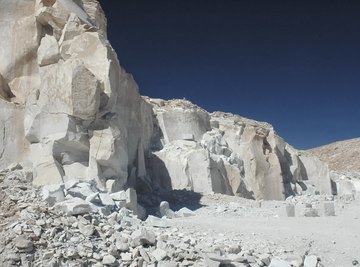
Phosphates and sulfates (the British spelling is "sulphates") share similarities in that both are salts of acids and both occur in nature as minerals. However, their molecular structures differ, they form from different acids, they comprise different minerals and they serve different purposes.
Molecular Structure
A sulfate compound's molecular structure contains a metal or radical plus SO4, or one sulfur atom and four oxygen atoms. A phosphate compound molecule contains a metal plus one phosphorus atom and four oxygen atoms, or PO4.
Acids
While phosphates are salts of phosphoric acid (H3PO4), sulfates are salts formed from sulfuric acid (H2SO4). Acids form salts when their hydrogen atoms are replaced with metals or radicals. With three replaceable hydrogen atoms in each molecule, phosphoric acid is considered tribasic; with one hydrogen atom replaced it forms monophosphate salt, with two replaced it forms diphosphate salt and with three replaced it forms trisphosphate salt. Each molecule of sulfuric acid, however, has only two replaceable hydrogen atoms. When both hydrogen atoms are replaced, sulfuric acid forms normal sulfates; when only one is replaced, it forms acid sulfates, hydrogen sulfates or bisulfates.
Minerals
Many minerals are classified as sulfates; some of the more common ones that occur in nature include gypsum (hydrated calcium sulfate), barite (barium sulfate) and anhydrite (calcium sulfate). Sulfate minerals are typically glassy in appearance, average to above average in density and average in hardness. Some are water soluble, and several are even fluorescent.
The most common phosphates found in nature are from the apatite group: chlorapatite, fluorapatite and hydroxylapatite. Less formally, these are grouped as calcium phosphates, which are occasionally found in mineral form but also comprise the bones and teeth of many living creatures.
Uses
Different sulfates are used as algicides and pigments. One, sodium lauryl sulfate, is a grease-removing detergent that is also used in shampoos and toothpastes. Various phosphates are used in soaps, detergents, glass, fertilizers, baking powders and laxatives. The term "phosphate" also sometimes refers to a non-alcoholic beverage made of carbonated water, flavored syrup and a little phosphoric acid.
References
About the Author
A native Midwesterner, Kristie Bishopp has been writing professionally since 1992. She started out as a technical writer and editor for a newsletter firm, then wrote several novels published under various pen names. Bishopp holds bachelor's degrees in magazine journalism and English literature from the University of Missouri-Columbia.
